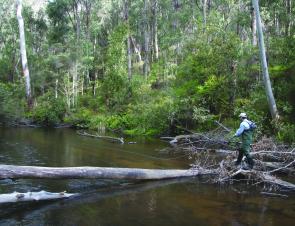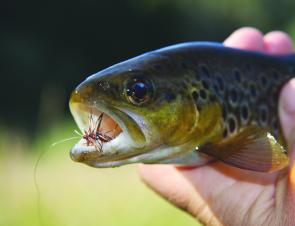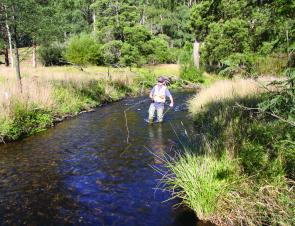Many anglers are of the mindset that the further away a fishing spot is, and the longer it takes to get there, the better the fishing will be. Sometimes it is. Other times, hours spent on the road could be better used exploring angling destinations closer to home.
Freshwater anglers from Melbourne and southern Victoria are blessed with a plethora of great trout streams right on their doorstep. There are no better examples than those around the sleepy township of Noojee in West Gippsland. In particular, the Latrobe, Toorongo and Loch rivers are three such streams that provide top shelf trout angling in a scenic rural environment. Best of all, Noojee is within easy reach for day trippers from the southern capital.
Make no mistake, the streams around Noojee are not exactly trophy trout waters. You should expect to catch trout that are mostly 20-35cm in length. Occasionally you will hook larger specimens, especially in the Latrobe, but any fish approaching 1kg would be exceptional. The trade off is that the trout populations in the Loch, Toorongo and upper Latrobe can be extraordinarily high. A dozen fish, or even more, in a short afternoon session is not unusual at some times of the year.
Traditionally, most trout around Noojee are brown, and under normal circumstances that is mostly what you will catch. Nevertheless, rainbow trout are present in all three rivers, especially in the Latrobe, and in the lower reaches of the Loch and Toorongo near their confluence with the Latrobe. Around a year ago, however, there was a remarkable run of rainbow trout in the Latrobe River, especially immediately downstream of Noojee. There were so many of these small, hungry rainbows it was difficult to get past them to the browns.
The Latrobe River rises from a collection of feeder streams northwest of Noojee, then flows through Yallourn Storage Dam and ultimately into Lake Wellington near Sale many kilometres distant. Some of the best trout angling occurs in its headwaters above its junction with the Toorongo River.
The Latrobe is the largest river in the Noojee region, and provides anglers with the best chance of a better class of fish. As with most streams in the region, access to the water is often precluded by dense bankside vegetation. As a result, the most effective way to fish is to wade upstream between access points – fishing as you go, of course.
There is easy access to the Toorongo River junction, at which point there is a large pool where trout often lurk in the swirling, mixing currents of the two streams. Chest waders are required to wade the section of upstream from here to Noojee. At most times the water is around 1m deep, though there are some deeper holes that require careful negotiation. There are also plenty of logs across the river, which further hinder progress. Nevertheless the bottom is mostly firm gravel, and there are a number nice pools connected by gentle riffles.
The Latrobe River flows right past Noojee and the section of river bordering the town park is a handy section of river from which to pull trout. There always seems to be a lot of fish here despite it getting its fair share of angling attention.
Moving upstream from Noojee, beyond the Loch River junction, the river becomes gradually smaller. Access is off the Powelltown-Noojee Road and though the vegetation is denser and the fishing tighter, the rewards are there for those that persevere. This is a long stretch of river in a scenic setting that contains good numbers of trout.
For some reason, even under ideal weather conditions the Latrobe River often seems to have a slight ‘tea-stained’ colour to it. Upstream of Noojee, anglers also have the opportunity of exploring a number of smaller tributaries, including the Ada River, all of which contain trout.
The Toorongo River and the Loch River are essentially feeder streams of the Latrobe River, though keen anglers view them as separate and important rivers in their own right. There is good access to both and they are easy streams to fish, though the Toorongo is marginally larger. Fish in the Toorongo are generally slightly bigger than Loch River fish, too.
The Toorongo is fed by a proportion of snowmelt and can be clear enough to fish when other streams in the region are dirty. It joins the Latrobe River not far downstream from Noojee. Above this junction there is a long stretch of good water that is accessible at several points along the road that leads to the Toorongo Falls. For much of the section between the Latrobe junction and the falls, at least one side of the river is cleared farmland, which makes for easy walking and provides a clear backcast for those waving the long wand. Again, the most effective way to fish is to hop in the water and work your way upstream.
Above the Toorongo Falls, the river splits in two and there is some great fishing in both forks. This section of river requires some real bush-bashing to get to, but anglers that go to the trouble should be rewarded by some top shelf wilderness fishing. Sight fishing to small brown trout can be effective here.
The Loch River is a small stream that gathers in the Noojee State Forest and joins the Latrobe River on the western outskirts of Noojee. It collects a proportion of snowmelt, but is primarily rain fed. For much of its length, the Loch is less than 3m wide and around 50cm deep. This river at times contains a very high population of small brown trout – perhaps more than most others in the region. The bottom is firm sand or gravel, and wading is safe in many places.
Access is to the Loch River is easy. The stream runs close to the Loch Valley Road for several kilometres and there is access from two camping areas, several road bridges, and straight off the side of the road in numerous spots. Like the Toorongo, there are significant sections of the Loch River where one or both banks are cleared farmland. The Loch also runs through sections of thick bush, where the fishing is more difficult, but where angling pressure is probably less as a result.
Flyfishers will be well served by a 5-weight rod with a matching floating line. A double taper line will suffice, as casting distances are not very long. Early in the season, when the water is higher and often discoloured, bead-head nymphs or dark, scruffy wet flies are a good choice. Later in the season a dry fly such as a small Red Tag or Royal Wulff can prove deadly. Though the small trout in this area are aggressive feeders and not usually very fussy, approaching from downstream is still prudent to avoid detection. Mostly you’ll be fishing blind, but if you wait quietly at most pools you will also find rising fish to cast to. Keeping leaders short facilitates accurate casting amongst the close vegetation – 2m at most is all you need, often even less.
Lure fishing is also a popular technique in these West Gippsland streams. Again, finesse is the name of the game, so keep gear on the light side. A 1.7m spinning rod coupled with a 2000 size threadline reel is ideal. Line should be light as well. Monofilament is fine, I like 4-6lb Fireline, which is as thin as cotton and enables easy casting of even the smallest spinners. The smallest sized Celtas or Mepps bladed spinners in a dark colour are effective, especially when the water is discoloured. Small Rapalas and similar hard-bodied lures work well too, as do small soft plastics (3 inches at most) rigged on the lightest of jig-heads.
Baitfishing enthusiasts won’t be disappointed in these parts either, and the king of baits is the humble earthworm. In fact, when conditions are really bad, the age-old technique of soaking a worm in a deep, slow pool can be the only feasible way of connecting with fish. When conditions allow, however, it’s better to deploy worms more actively by drifting them unweighted through the deeper runs. Fishing with worms also puts you in the frame for river blackfish. In summer the countryside around Noojee can be alive with grasshoppers and other terrestrials, so a spot of ’hopper fishing can be rewarding.
There is good fishing available around Noojee right throughout the trout season, but some times of year are better than others. Fishing straight after opening can be productive, but the efforts of anglers are often disturbed by the unsettled weather that is characteristic of early spring in these parts. Torrential downpours are common and lead to high, dirty and virtually unfishable water, so it’s best to get good local information before leaving home. Happily it doesn’t usually take long for the rivers to drop and clear once the rain dissipates.
Probably the best trout fishing in these rivers occurs from Christmas through to mid-April. At this time, sustained periods of fine weather lead to ideal levels of clear water. There is also an increased level of insect activity, particularly the larger terrestrials, which in turn brings flurries of activity from the fish. Added to this is a higher population of trout in the Loch, Toorongo and upper Latrobe as the fish migrate upstream trying to escape warmer water temperatures lower down in the Latrobe.
Noojee is approximately 90 minutes drive from Melbourne via the Monash and Princes freeways. Turn off at the Robin Hood Hotel and head through Neerim South. If approaching along the Princes Highway from the east, head north when you hit Warragul.
So what are you waiting for? The rolling green hills of West Gippsland around Noojee offer some great trout streams. On a sunny day I can’t think of a more pleasant place to be. The trout are plentiful and almost always co-operative - plus you don’t have be Malcolm Douglas or Alby Mangles to get there. Why not get your own backyard in order before racing off on your next exotic fishing trip?
Facts
USEFUL INFORMATION
Supplies
For anglers travelling from Melbourne, a handy place to grab last minute angling supplies or licences is at Paul Worsteling’s Shimano World in Berwick (03 9704 2200). It is conveniently located on the Princes Highway. Alternatively, try Bisho’s Bait and Tackle at 139 Queen St, Warragul (03 5623 1944), or - for anglers coming from the other direction - Alpine Country in Saskia Way, Morwell (03 5134 1380).
For lunch and drinks there are shops in Noojee, plus a pub that serves counter meals.
Maps
Topographic maps are useful for finding the access routes and travelling up and down the river. In the Vicmap 1:25,000 series, the appropriate map is Neerim (8022-2-2) and those adjacent to this (depending on which streams you want to fish).
Camping
For those who want to extend their stay there is free camping at a number of public campgrounds on the banks of all three rivers. Contact the Department of Sustainability and Environment in Noojee for details (03 5624 8100).











